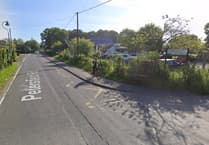Having towered over Petersfield Square for over 250 years, for many, the statue of Protestant King William III, or ‘King Billy,’ has come to symbolise the town.
It was commissioned in 1750 after Sir William Jolliffe, the then local MP, left money in his will for it.
It was erected in 1757 outside the Jolliffe family mansion, Petersfield House, that sat roughly where Petersfield Infants School in St Peter’s Road is now.
The Jolliffe family came to prominence in the town when John married Catherine Michel.
She was the daughter and heir of Robert Michell, a Member of Parliament (MP) for Petersfield.
On marrying Catherine, John gained control of one of two parliamentary seats in the borough of Petersfield.
He used that to return his uncle Sir William Jolliffe as MP – Sir William later commissioned the statue.
Then in 1734, John bought the manor of Petersfield from Edward Gibbon, giving him control of the second seat.
John sat as MP for Petersfield from 1741 to 1754, and again from 1761 to 1768.
He had three sons, William (1745 to 1802), who was MP for Petersfield from 1768 to 1802, Thomas Samuel (1746 to 1824), MP for Petersfield 1780 to 1787, and Charles, who was killed at the Battle of Waterloo.
Petersfield House was pulled down in the 1790s, and the statue moved to the market square.
It was mark of the Jolliffe’s Protestent faith at time when religious fervour was at a peak, with the Protestent majority in fear of a Catholic resurgence.
The lead statue also publicly announced the Jolliffes support for the Protestent William Of Orange (1650 to 1702), King of England, Ireland and Scotland from 1689 until his death.
William of Orange, was Prince of Orange from birth, Stadtholder of Holland, Zeeland, Utrecht, Guelders and Overijssel in the Dutch Republic.
As King of Scotland, he is known as William II.
He is also sometimes informally known as ‘King Billy’ in Northern Ireland and Scotland, where his victory at the Battle of the Boyne on July 1 in 1690 is still commemorated by Unionists and Ulster loyalists.
In Petersfield, at the end of June members of Loyal Orange Lodge from Portsmouth march with band from the station to the Square, where a wreath is laid at the statue, and then to Petersfield Heath where a short commemorative thanksgiving is held.
William was the only child of William II, Prince of Orange, and Mary, Princess of Orange, the daughter of King Charles I of England.
In 1677, during the reign of his uncle King Charles II of England, he married his cousin Mary, the 15-year-old daughter of Charles II’s brother James.
In coalition with Protestant and Catholic powers in Europe, William, a Protestent, campaigned in several wars against Catholic King Louis XIV of France.
Many Protestants heralded him as a champion of their faith.
In 1685, his Catholic uncle and father-in-law, James, became King of England, Scotland and Ireland but his reign was unpopular with the Protestant majority.
Supported by leading British political and religious leaders, William invaded England in what was known as the Glorious Revolution.
In 1688, he landed at the south-western English port of Brixham.
Shortly afterwards, James was deposed.
William’s reputation as a staunch Protestant enabled him and his wife to take power.
During the early years of his reign, he was occupied abroad with the Nine Years’ War from 1688 to 1697.
Queen Mary II died in 1694. In 1696, the Jacobites plotted unsuccessfully to assassinate William and return his father-in-law to the throne.
Upon his death in 1702, William was succeeded in Britain by Anne and as titular Prince of Orange by his cousin, John William Friso.
In Petersfield, the statue, just one of a handful of William across the UK, has been repaired and refurbished several times over the years.
Since Petersfield Urban District Council purchased William III for the town in 1911, it has been repaired at least seven times.
The statue was originally gilded, but William lost his sheen when he was tarred and feathered by opponents of the Jolliffe election campaign.
Then in September 1913, Petersfield residents held jumble sales and concerts to raise money to repair it again.
The townspeople filled the Square to celebrate the unveiling of the newly restored statue, which was decorated with laurel leaves.
There were speeches and music from the band of the 6th Hants Territorials.
The town’s complicated relationship with its statue continues to this day, as William III has once again found himself in need of repair.
On August 28 William’s arm came adrift of his torso.
Repairs are now the responsibility of Hampshire County Council.
Love him or hate him, we hope you will join us in wishing William all the best for a speedy recovery.




